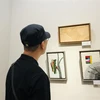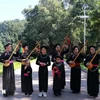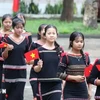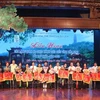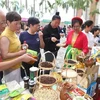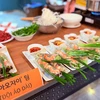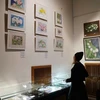Sixty gong troupes from five Asian countries and 24 cities and provinces in Vietnam kicked off the first International Gong Festival in the Central Highland province of Gia Lai on Nov. 12 night.
The four-day festival, organised by the provincial People’s Committee and the Ministry of Culture, Sports and Tourism, has attracted thousands of local and foreign visitors.
Taking part are some 1,000 performers of 11 ethnic minority groups from the provinces of Kon Tum, Dak Lak, Dak Nong, Lam Dong, Nghe An and Hoa Binh as well as troupes from Laos, Cambodia, Indonesia, Myanmar and the Philippines.
The festival will include religious ceremonies accompanied by gong orchestras, a buffalo festival, tomb abandonment ceremonies, seminars on preserving gong music, and exhibitions on ethnic minority cultures.
Provincial ethnic groups, including the Jrai, Ybrom, E De and Bahnar, will take part in rain worship and New Year ceremonies.
The festival aims to preserve the region’s unique gong culture recognised by UNESCO as an oral and intangible heritage of mankind.
Gong have been used for more than 3,000 years in Vietnam and have played a key role in the ethnic communities’ culture.
Because it is seen as a tool that helps connect them with heaven, gong culture is an inseparable part of the ethnic minority people’s spiritual life.
Gia Lai, which has 5,655 sets of gongs owned by various families, has the highest number of gongs in any of the Central Highland provinces. The nearby province of Dak Lak has 300 sets, and Kon Tum has 1,800.
Gongs are played to celebrate special occasions, including house warmings, the birth of a baby, weddings, ritual parades and funerals.
Attending the ceremony, head of the Party Central Committee’s Commission for Mass Mobilisation Ha Thi Khiet said that gong culture united Southeast Asian nations.
“Gong culture is not only an invaluable property of ethnic groups in the Central Highlands, but for all Southeast Asian nations,” she said. “We have to preserve and promote it for future generations in Southeast Asian region and around the world.
“The festival plays an important role in preserving this culture as well as in uniting Southeast Asian nations./.
The four-day festival, organised by the provincial People’s Committee and the Ministry of Culture, Sports and Tourism, has attracted thousands of local and foreign visitors.
Taking part are some 1,000 performers of 11 ethnic minority groups from the provinces of Kon Tum, Dak Lak, Dak Nong, Lam Dong, Nghe An and Hoa Binh as well as troupes from Laos, Cambodia, Indonesia, Myanmar and the Philippines.
The festival will include religious ceremonies accompanied by gong orchestras, a buffalo festival, tomb abandonment ceremonies, seminars on preserving gong music, and exhibitions on ethnic minority cultures.
Provincial ethnic groups, including the Jrai, Ybrom, E De and Bahnar, will take part in rain worship and New Year ceremonies.
The festival aims to preserve the region’s unique gong culture recognised by UNESCO as an oral and intangible heritage of mankind.
Gong have been used for more than 3,000 years in Vietnam and have played a key role in the ethnic communities’ culture.
Because it is seen as a tool that helps connect them with heaven, gong culture is an inseparable part of the ethnic minority people’s spiritual life.
Gia Lai, which has 5,655 sets of gongs owned by various families, has the highest number of gongs in any of the Central Highland provinces. The nearby province of Dak Lak has 300 sets, and Kon Tum has 1,800.
Gongs are played to celebrate special occasions, including house warmings, the birth of a baby, weddings, ritual parades and funerals.
Attending the ceremony, head of the Party Central Committee’s Commission for Mass Mobilisation Ha Thi Khiet said that gong culture united Southeast Asian nations.
“Gong culture is not only an invaluable property of ethnic groups in the Central Highlands, but for all Southeast Asian nations,” she said. “We have to preserve and promote it for future generations in Southeast Asian region and around the world.
“The festival plays an important role in preserving this culture as well as in uniting Southeast Asian nations./.
